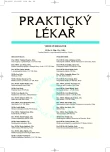Extensive trombosis of thoracic aorta – an unusual source of acute peripheral arterial embolism.
Authors:
J. Mácha 1; K. El Samman 2; B. Míková 3; P. Niederle 1
Authors‘ workplace:
Kardiologické oddělení
Přednosta: prof. MUDr. Petr Niederle, DrSc.
1; Oddělení cévní chirurgie
Přednosta: doc. MUDr. Pavel Šebesta, CSc.
2; Radiodiagnostické oddělení
Přednosta: MUDr. Ladislava Janoušková, CSc.
Nemocnice Na Homolce, Praha
Ředitel: MUDr. Vladimír Dbalý
3
Published in:
Prakt. Lék. 2007; 87(4): 238-240
Category:
Case Report
Overview
The case of a 58 year old patient with acute arterial occlusions of both lower limbs is presented. Bilateral embolectomy (Fogarthy’s catheter) was performed immediately, followed by attempts to discover the source of potential emboli. Transoesophageal echocardiography (TEE) detected extensive thrombosis of the descending aorta. Its peripheral tail was considered malignant. The finding was confirmed by computer tomography examination (CT angiography). A decision was made, taken together with the patient, to administer the conservative anticoagulant treatment. Both diagnostic imaging techniques were repeated after four months and their results indicated almost complete regression of the original aortic thrombosis with no other embolic events. This uncommon and remarkable case emphasizes the substantial role of TEE in the diagnosis of potential embolic sources.
Key words:
Aortic thrombosis, arterial embolisation, transoesophageal echocardiography.
Labels
General practitioner for children and adolescents General practitioner for adultsArticle was published in
General Practitioner

2007 Issue 4
Most read in this issue
- Todays trends of diagnostics and treatment of scaphoid bone fractures
- Extensive trombosis of thoracic aorta – an unusual source of acute peripheral arterial embolism.
- Epileptic fit as a syncope equivalent in severe aortic stenosis.
- Smoking and skin
